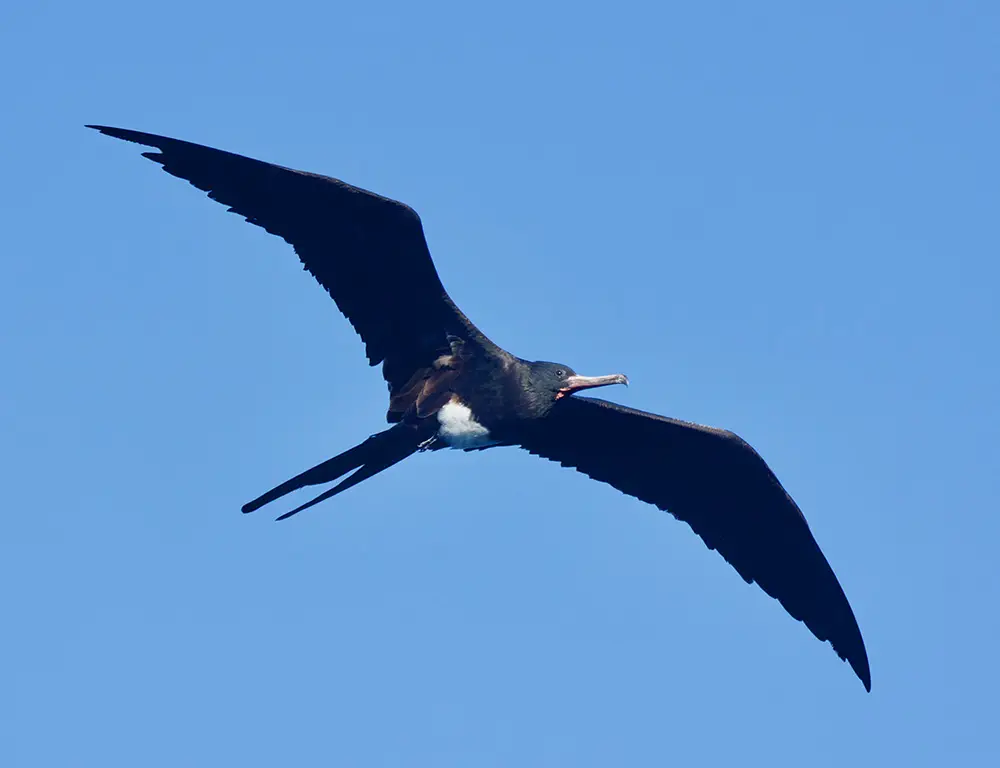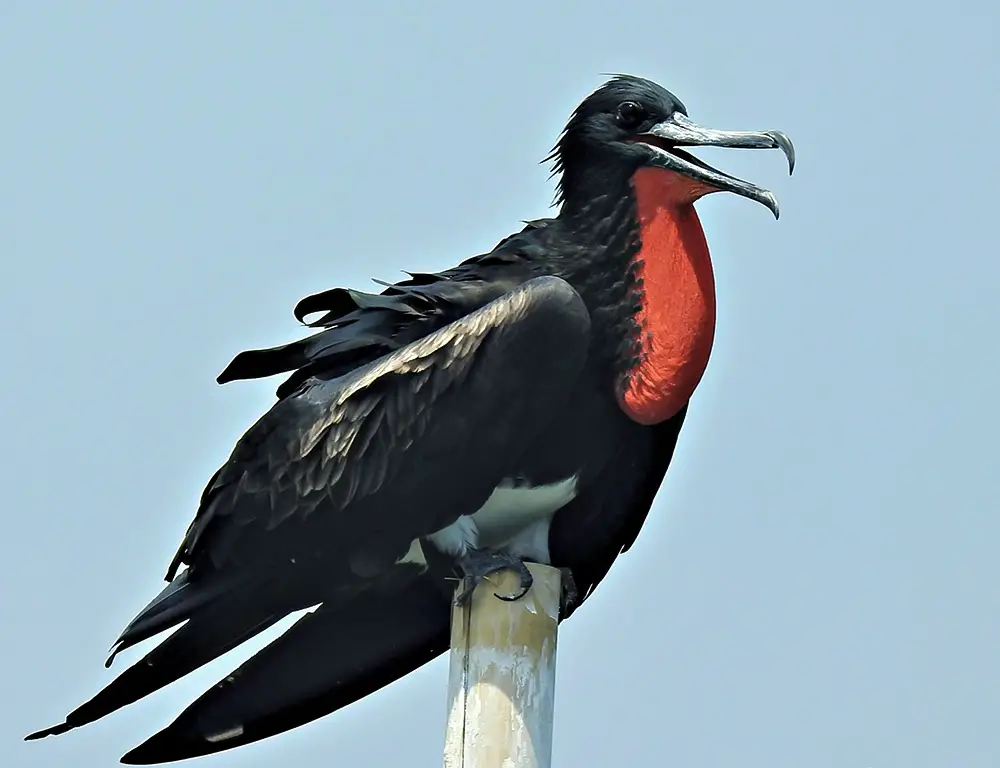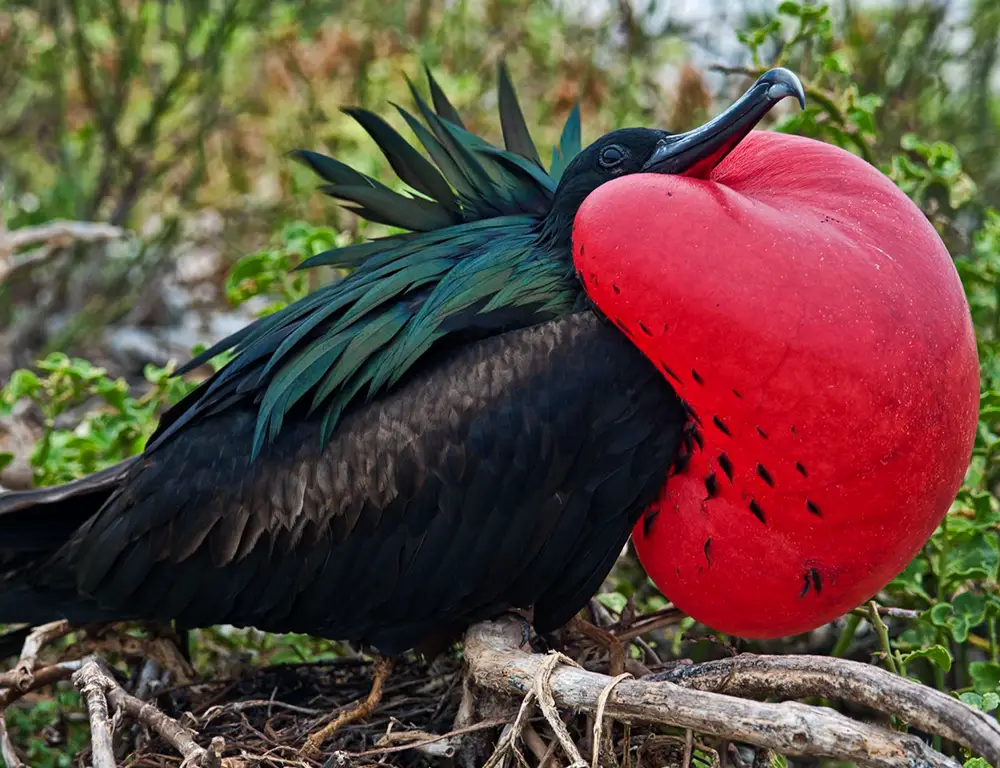Known for its striking black and white plumage, the Christmas Frigatebird is a unique species native to the Christmas Island in the Indian Ocean.
It’s an ocean-dwelling bird that spends most of its time soaring over the sea, diving down only to snatch up prey from the water’s surface.
The Christmas Frigatebird has an impressive wingspan reaching up to 2.3 meters (or roughly 7.5 feet), making it one of nature’s most skilled fliers.
With a name derived from its home, the Christmas Frigatebird is not just your average seabird. The International Union for Conservation of Nature (IUCN) classifies this particular species as critically endangered.
It faces numerous threats, primarily habitat loss due to phosphate mining on Christmas Island and invasive species like Yellow Crazy Ants.
However, efforts are underway to conserve this remarkable bird and its fragile ecosystem. Experts and environmental organizations are working tirelessly to mitigate these threats and ensure that future generations can witness the majestic flight of the Christmas Frigatebird.

Physical Characteristics of Christmas Frigatebird
The Christmas Frigatebird (Fregata andrewsi) boasts several distinctive physical characteristics that make it an intriguing and unique seabird:
Size and Weight
Christmas Frigatebirds are relatively large birds with a wingspan that can reach up to an impressive 2.3 meters (7.5 feet). On average, they stand about 100 centimeters (39 inches) tall. Despite their size, they are surprisingly lightweight.
Adult males typically weigh between 1.04 and 1.41 kilograms (2.3 to 3.1 lbs), while females can weigh up to 1.59 kilograms (3.5 kg).
Gender Dimorphism
There are slight differences in size and weight between male and female Christmas Frigatebirds. Adult males are generally slightly smaller and lighter than females.
Coloration
Christmas Frigatebirds exhibit striking coloration, especially during breeding seasons. Males have predominantly black plumage, but during courtship displays, they inflate a bright scarlet-red throat pouch, which is highly conspicuous.
In contrast, females have black bodies with white bellies and underwing coverts, creating a clear visual distinction from the males. Juveniles start with a white head that gradually darkens as they mature.
Wings and Flight

These birds have long, narrow wings and a deeply forked tail, which enables them to soar effortlessly over the ocean for extended periods. They are highly skilled fliers, capable of covering vast distances for food.
Beak and Feet
Christmas Frigatebirds have long, hooked beaks adapted for catching prey, particularly flying fish and squid. Their feet are relatively small and weak, limiting their mobility on land but aiding in gripping prey during flight or perching on branches.
Habitat and Distribution of Christmas Frigatebird
The Christmas Frigatebird (Fregata andrewsi) has a unique habitat and distribution pattern that reflects its specialized breeding and foraging behaviors:
Breeding Locations
Christmas Island in the Indian Ocean is the primary nesting ground for Christmas Frigatebirds. This remote island provides ideal conditions for nesting, including vast expanses of tropical rainforest and ample food resources from the surrounding ocean.
It’s estimated that approximately 95% of the global population breeds on Christmas Island. However, a smaller percentage also breeds on other islands scattered across Indonesia and Australia, such as Java and Kimberley, where suitable habitats are available.
Migration Patterns
Like many other bird species, Christmas Frigatebirds are not known for undertaking long-distance seasonal migrations. Instead, they tend to stay within a relatively confined geographical range throughout their lives.
While they are non-migratory, they are exceptionally skilled flyers and spend most of their time soaring high above the ocean waves.
They may venture hundreds of kilometers from land in search of food. Juvenile frigatebirds, in particular, may disperse over more expansive areas before returning closer to their natal colonies.
Overall distribution data for Christmas Frigatebird:
| Location | Percentage |
|---|---|
| Christmas Island | 95% |
| Other Islands (Java, Kimberley etc.) | 5% |
Habitat Choice and Adaptability
The selective habitat choice of Christmas Frigatebirds, coupled with their non-migratory lifestyle, makes them unique among seabirds. They have adapted to their oceanic environment, expertly navigating their world with an innate sense of belonging.
Diet and Feeding Habits of Christmas Frigatebird

The Christmas Frigatebird (Fregata andrewsi) has fascinating and unique feeding habits adapted to its oceanic lifestyle. Here’s an overview of its diet and feeding behaviors:
Prey
Christmas Frigatebirds primarily feed on flying fish and squid, which they snatch from the ocean surface while soaring overhead.
Flying fish are a preferred prey, as they become easy targets when they leap out of the water to escape underwater predators.
Squid are also caught near the water’s surface using similar hunting techniques.
Hunting Techniques
- Snatching Mid-air: Frigatebirds have exceptional aerial agility and use it to their advantage when hunting flying fish. They swoop down from the air and grab flying fish in mid-air using their hooked beaks before they can dive back into the water.
- Catching Near Water Surface: Similarly, frigatebirds catch squid near the water’s surface, utilizing their sharp eyesight and rapid aerial maneuvers to capture them efficiently.
Kleptoparasitism
Christmas Frigatebirds are known for their kleptoparasitic behavior, where they steal food from other seabirds. They harass other birds until they drop or regurgitate their catch, then swoop in to claim the stolen food.
This opportunistic behavior allows frigatebirds to capitalize on the efforts of other birds without expending much energy themselves.
Following Ships and Fishing Boats
Frigatebirds have been observed following ships and fishing boats, taking advantage of the disturbed water and any escaping prey.
They scavenge for food scraps or catch escaping prey that is disturbed by the vessels, demonstrating their adaptability to various feeding opportunities in their environment.
Here’s a brief overview:
| Food Items | Method of Hunting |
|---|---|
| Flying Fish | Snatching mid-air |
| Squid | Catching near water surface |
| Stolen Food | Kleptoparasitism |
Conservation Status of Christmas Frigatebird

The Christmas Frigatebird (Fregata andrewsi) is classified as critically endangered by the International Union for Conservation of Nature (IUCN), indicating that it faces an extremely high risk of extinction in the wild.
Here’s a summary of its conservation status and the efforts being made to protect it:
Population Estimates
Current estimates suggest that only 2,400 to 4,800 mature individuals of Christmas Frigatebirds are left in the wild. This represents a significant decline from historical population levels.
Population Trend
The Christmas frigatebird population has steadily declined over the past several decades. Historical population data indicates a reduction from around 6,000 individuals in 1980 to nearly 3,000 individuals by 2010.
This decline is attributed to various factors, including habitat loss and degradation, hunting, egg collection, and disturbances caused by human activities.
Here’s a brief overview of their population trend:
| Year | Estimated Population |
|---|---|
| 1980 | Around 6,000 |
| 1990 | Approximately 5,000 |
| 2000 | Roughly 3,500 |
| 2010 | Nearly 3,000 |
Threats
The primary threats to the Christmas Frigatebird include habitat loss and degradation, mainly due to phosphate mining operations on Christmas Island.
Additionally, hunting, egg collection, and disturbances caused by human presence further contribute to the decline of this species.
Conservation Efforts
Efforts have been implemented to protect the Christmas Frigatebird and its habitat. These include:
- Government protection of breeding grounds, such as Christmas Island, through the establishment of protected areas.
- Implement strict laws and regulations against hunting, egg collection, and other direct threats to the birds.
- Rehabilitation efforts aimed at restoring degraded habitats and reducing human disturbances in nesting areas.
Challenges
Despite conservation measures being in place, the population decline of Christmas Frigatebirds has not been halted. Ongoing threats continue to impact the species, highlighting the challenges in conserving this critically endangered bird.
Future Outlook
The future survival of the Christmas Frigatebird depends on continuous refinement and effective implementation of conservation strategies.
Addressing the root causes of population decline, such as habitat loss and human disturbances, is crucial for the long-term survival of this species.
Conclusion
The Christmas Frigatebird is a marvel of nature, captivating with its impressive wingspan and unique nesting habits. Endemic to Christmas Island, it faces significant challenges, including habitat loss and plastic pollution.
However, conservation efforts, such as declaring Christmas Island a National Park and reducing plastic pollution, offer hope for survival.
Understanding this species fosters appreciation for biodiversity and reminds us of our interconnectedness with the natural world.
Protecting the Christmas Frigatebird safeguards a single species and an entire ecosystem. As stewards of the Earth, it’s crucial for us to recognize the importance of each creature and our role in maintaining balance in our environment.
Let us continue to work together to protect and preserve the wonders of nature for future generations.